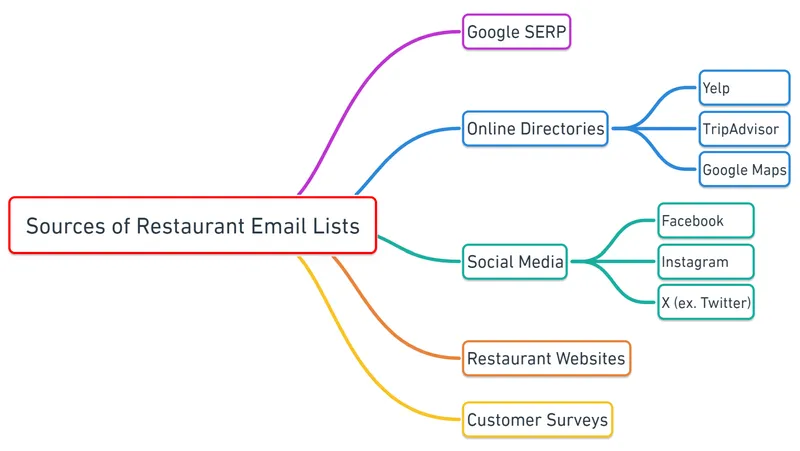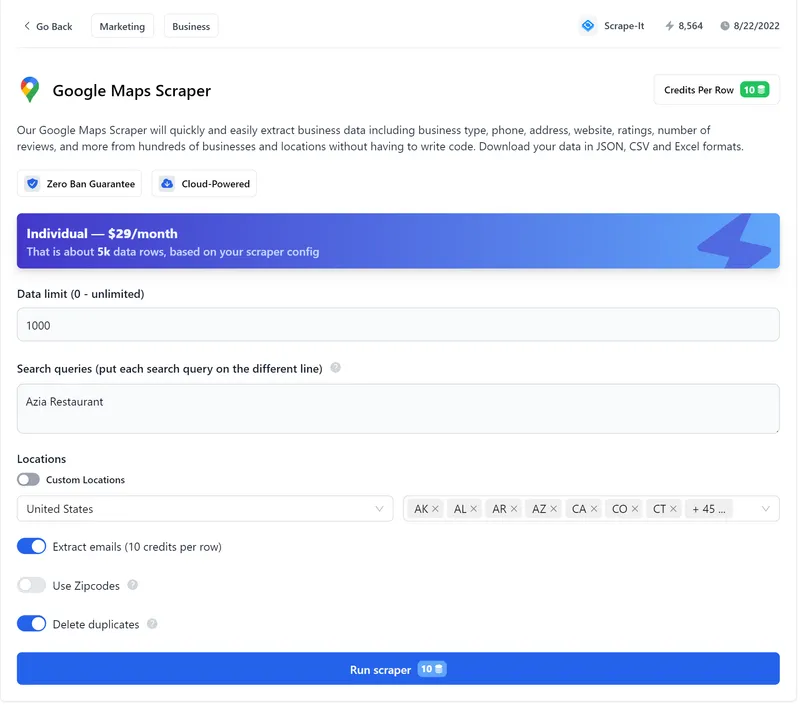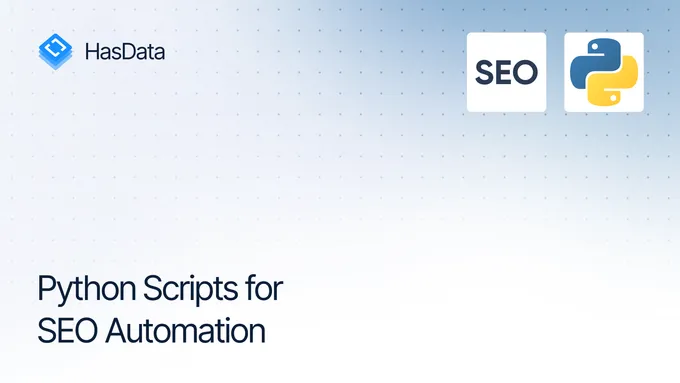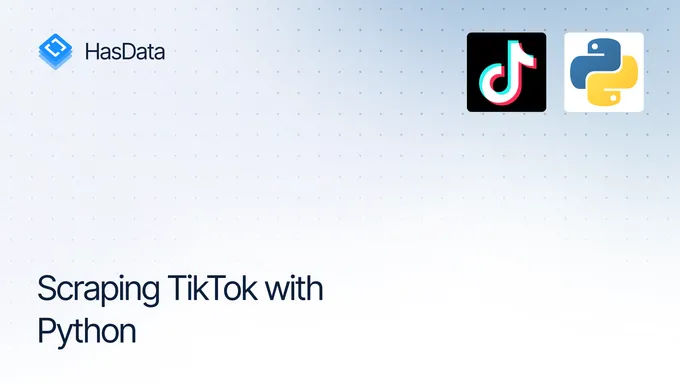How to Build a Restaurant Email List for Lead Generation
Creating a restaurant email list can be a valuable part of marketing campaigns for suppliers of goods, equipment, and services who want to build a list of potential customers among restaurant owners. In this article, we will discuss in detail who can benefit from creating their email list, why it is important, and how to get the most up-to-date and relevant data.
We will also discuss the challenges of creating a restaurant email list, how to overcome them, and provide tips and advice for getting the most comprehensive, up-to-date, and useful list of emails. We will also provide practical advice on how to use email marketing to attract new customers effectively.
Why restaurant email lists matter
Email list collection remains one of the most popular and in-demand options in Internet marketing for several reasons. In general, the effective use of restaurant email lists helps businesses maintain strong relationships with customers and increase sales.
To achieve this, suppliers can use email lists for targeted advertising and direct marketing, to inform about new changes and improvements, and about special offers that may be of interest to restaurant owners. This will help not only attract new customers but also help keep existing customers engaged, which contributes to customer retention.
One of the most popular areas of using email addresses of potential customers in the restaurant business is lead generation. We have already written about what lead generation is and why it is needed, so we will not dwell on it in detail. However, we note that email address collection is an important element that can be used to attract new customers effectively.
By properly using email and conducting email campaigns, suppliers can build and effectively maintain their brand. This helps to strengthen brand perception, create a positive impression, and attract new customers.
Who needs a restaurant email list?
Restaurant email lists are in high demand across a variety of industries, from food and beverage suppliers and equipment manufacturers to marketing agencies and delivery services. Regardless of how the list is ultimately used, collecting restaurant email addresses can be beneficial for any of these sectors.
For example, marketing agencies can use restaurant email lists to identify potential clients to whom they can offer their marketing services. Food and beverage suppliers and equipment manufacturers can use this data to find leads for their products and services. Delivery services, like suppliers, can use restaurant email lists to find partners and expand their customer base.
Regardless of who uses them, restaurant email lists are a powerful tool for customer acquisition, brand awareness, and marketing optimization in the restaurant industry.
Sources of Restaurant Data
Restaurant email lists can be collected from a variety of sources, each with its advantages and disadvantages. To ensure that you have a comprehensive and accurate list, it is best to use multiple sources.

Google SERP
Search engine results pages (SERPs) are one of the most popular data sources, along with Google Maps. Using SERPs as a data source allows you to extract not only contact information, including email addresses, but also name, address, and much more.
SERPs are one of the best data sources, as they provide access to an extensive database of restaurants. In addition, the data provided by them is up-to-date and is extracted from a reliable source, which can guarantee their reliability.
Unfortunately, this option has many limitations, namely, the difficulty of extracting data, as well as the limitedness of the provided data, which may not include the information necessary for a specific case.
To overcome these limitations, you can use multiple data sources. For example, you can combine SERP data with data from Google Maps or other restaurant directories. This will help you to ensure that you have complete and accurate information.
Online directories
Online restaurant directories, such as Yelp or TripAdvisor, are another great source of data. They provide extensive information about restaurants, including their addresses and contact information. This allows you to extract not only email addresses and phone numbers but also their addresses, websites, and social media links.
However, not all restaurants are represented in online directories, which can significantly limit the data you can collect. Additionally, not all online directories keep their data up-to-date, so it’s important to be aware that the information you collect may be outdated or incomplete and will need to be verified.
Social media
Social media is a reliable source of information about restaurants, as the data is provided directly by the restaurants themselves. Restaurant profiles on social media platforms like Facebook, Instagram, and Twitter can be a valuable source of information, including basic information about the restaurant, such as its location, hours of operation, menu, reviews and ratings, and even special offers and promotions.
While not all restaurants are active on social media, and the data available may be limited, social media can still be a valuable resource. It can provide personalized information about restaurants and their social media activity and be used to interact with potential customers through social channels.
Restaurant Website
Restaurant websites are another great source of information for suppliers. They often include contact information for owners and managers, as well as information about industry events where you can meet them.
You can also use the website’s contact form to reach out to restaurant owners and managers. Or, if the website has links to social media profiles, you can use those to connect with them as well.
Customer surveys
Customer surveys are a valuable source of information for both you and restaurant owners. By directly engaging with your audience and gathering feedback, you can build a base of active customers interested in your services. This also allows you to identify problems early, track customer needs, and measure the impact of your changes.
Surveys are a great option for suppliers with a website. However, they require active participation from suppliers, and the data they collect is valuable only to them. However, they are still a great way to learn about customer preferences and interests.
Building Your Own Restaurant Database
Now that we have covered the sources of data about restaurants, let’s discuss the methods of collecting it. We will explore both manual and automated data collection options.
Manual collection
The manual collection is the most time-consuming and labour-intensive method for collecting restaurant email lists. It involves manually searching for data by visiting restaurant websites, search engines, and online directories. This requires a significant amount of time and people to perform the search and data collection manually.
While manual data collection eliminates the technical challenges of scraping, it can lead to human errors such as typos or missing information. These errors can be costly, as they can prevent you from reaching potential customers or lead to inaccurate data analysis.
No-code scrapers
The easiest and fastest way to get the email addresses you need is to use no-code tools that allow you to collect the necessary data from specific resources automatically.
The most difficult part of using no-code scrapers to create a restaurant email list is finding a tool that supports the data source you need. For example, you can’t use a Yelp no-code scraper to collect data from Google SERP, and vice versa. So, if you decide to collect data with this tool, you’ll need to determine your data source first.
We’ve already covered how to collect email addresses from Google Maps and provided a step-by-step guide for using no-code scraper and other methods. To get restaurant emails from the Google Maps no-code scraper, go to the HasData panel and sign in. Then, go to the Scrapers page and find the Google Maps no-code scraper.
On the settings page, specify all the necessary parameters and make sure to check the box next to Extract Emails. You can specify any keyword, and localize your request, and then run the scraper.

After the scraping process is complete, you can find a list of tasks on the right side of the screen. You can download the necessary data in one of the available formats: CSV, JSON, or XLSX. As a result, you will receive a file with data in the following format (a few columns were hidden):

Collecting data from other resources is done the same way, you can find different no-code scrapers on our website for collecting data from Yelp, Yellow Pages, Google SERP, and more.
A huge advantage of using specialized tools is that they require no coding skills. All you need to do is choose a tool, configure filters to get relevant data and start the collection process.
Integration services
If you want to configure the data collection sources and then automatically add the collected data to your database without writing any code, you can use integration systems such as Make.com or Zapier.
These systems offer a wide range of applications that you can integrate into your application. They provide access to both data collection services from any source and special integrations for further data processing and storage.
If you are new to these services, you can start by learning how to create integrations in Zapier or by looking at our step-by-step tutorial on how to create an email list using Make.com.
Using integration systems allows you to collect the data you need and easily process it. They can be used by anyone to create a flexible tool that can meet their specific requirements and automatically solve any task.
APIs
The last way to create your restaurant email list is by using various APIs to automate data collection from multiple sources. This option has both its advantages and disadvantages.
Using APIs allows you to create a fully customized tool that meets all your needs. Additionally, you can integrate it into your app to optimize the data collection and processing process.
However, using APIs for data collection requires programming skills that may not be available to everyone. Although this is the most flexible option that allows to collect and process all the necessary data automatically, it can be too difficult for those who are not familiar with programming.
Challenges with Database Creating
To create a successful email list, you need to be aware of the challenges you may face. It is also important to know how to overcome these challenges and what to focus on.
Finding the right data sources
As we mentioned earlier, there are many different sources of restaurant data available, but not all of them are reliable or accurate. Some sources may be outdated or contain inaccurate information, which can make it difficult to find and gather up-to-date and accurate data.
To avoid this problem, it is important to use only sources of information that are reliable and that are constantly updated, thereby providing only the most current information. Such sources can include data from restaurant websites and pages, as well as data gathered from Google SERP.
Cleaning and verifying data
Before adding email addresses to a database, they must be validated to ensure that they are valid, active, and up-to-date. Invalid or outdated addresses can lead to low email deliverability, damage the sender’s reputation, and even lead to complaints and damage your brand.
Email validation can be performed in two steps: syntax validation and existence verification. Syntax validation checks whether an email address conforms to the RFC 5322 standard, which defines the syntax and format of email addresses. Existence verification checks whether an email address is associated with a valid mailbox on an active mail server.
Compliance with email laws
Email marketing laws, such as the CAN-SPAM Act, require marketers to comply with certain regulations when collecting and using email addresses. These regulations include providing an opt-out option, clearly identifying the sender and subject of the email, and not disclosing personal information without consent.
Data update management
Maintaining an accurate restaurant database is essential for successful email campaigns. Restaurants change contact information, owners, and even close all the time, so it’s important to keep your database up-to-date.
There are a few ways to maintain your database. You can manually update it by visiting restaurant websites and social media pages or use a third-party service to update your database automatically.
Regularly updating your database will help you reach the right people with your email campaigns. When your database is accurate, you can be sure that your emails are going to the people who are most likely to be interested in your service.
Best Practices and Recommendations
To create an effective and relevant restaurant email list for lead generation, you need to follow these steps:
- Define your target audience. The more specific you are about your target audience, the more relevant your email list will be. To make your list as relevant as possible, specify parameters such as location, restaurant size, and other details.
- Collect data from multiple sources. Collecting data from multiple sources will help you to verify and supplement your existing data. This will help to reduce the number of inaccurate or outdated records.
- Segment your data. Segmenting your email list by different criteria will allow you to personalize your email campaigns more effectively. For example, you could segment your list by location, size, or needs.
- Update and optimize your data regularly. It’s important to regularly update and optimize your email list to ensure that it is accurate and up-to-date. This includes removing any inaccurate or outdated records.
Creating an effective restaurant email list takes time and effort, but it is worth it. A well-maintained email list can help you to generate leads, increase sales, and build relationships with your customers.
Conclusion
Building a restaurant email list can help you run more effective email marketing campaigns to attract new customers among restaurant owners. In this article, we discussed not only why this is important, but also the various sources from which you can obtain the necessary data.
In addition, we discussed many approaches and tools that allow you to collect a relevant database that is most up-to-date and suitable for your marketing campaign. We also looked at the main challenges that you will face in the process of collecting and processing a restaurant email list and ways to overcome them.
Some tools and solutions can help you create an email list of restaurant owners. By following best practices, you can create a database that is accurate, reliable, and compliant with data privacy regulations.


